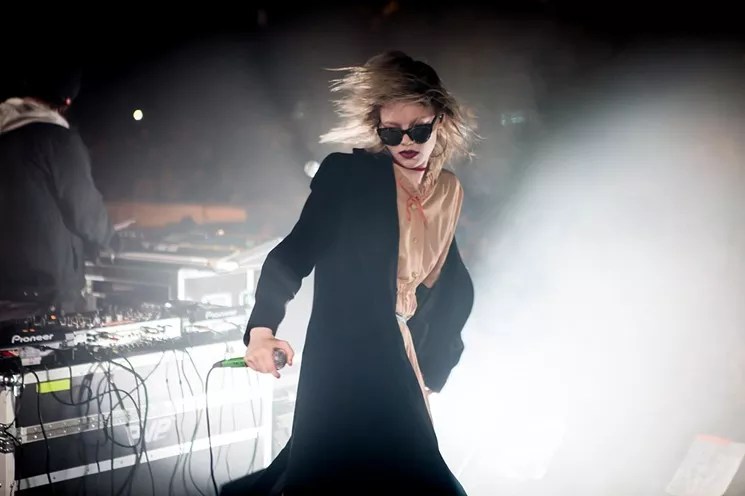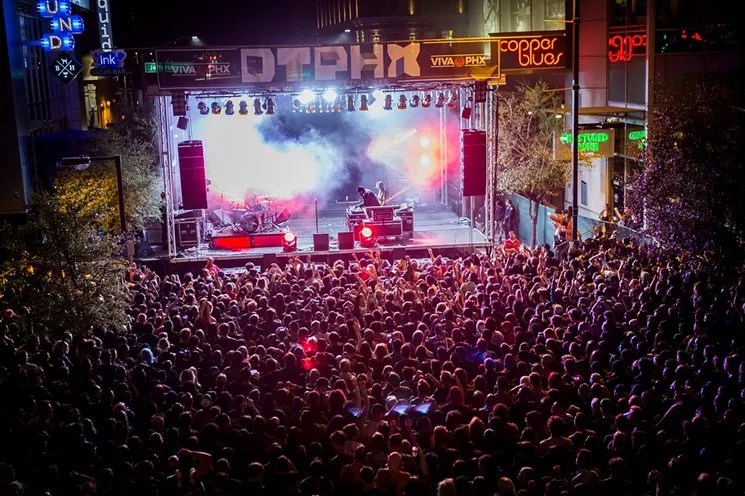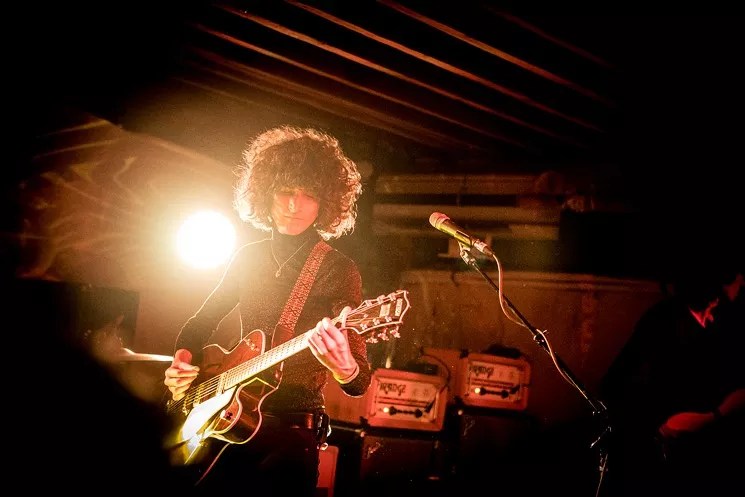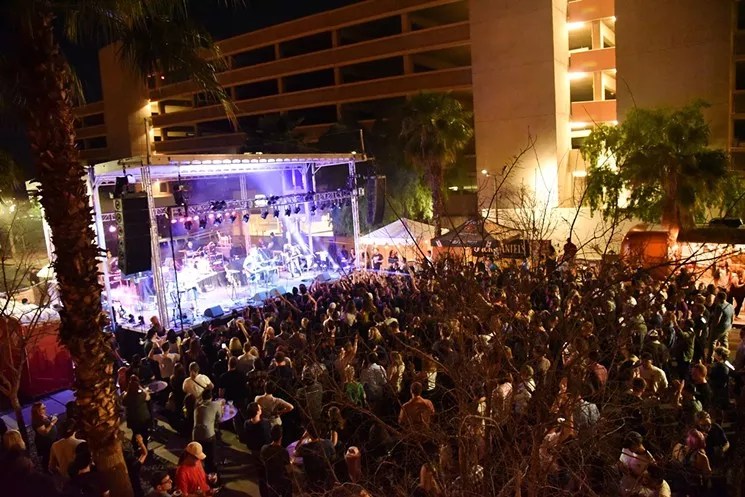
Courtesy of Melissa Fossum

Audio By Carbonatix
Phoenix often feels like a city perpetually taking one step forward, two steps back. And not just because we lost a Planet Hollywood franchise that one time.
The cancellation of Lost Lake in 2018 made clear that for every inch earned toward Phoenix’s immersion on the national arts stage, something occurs to stymie the resulting impact (economic and otherwise). That despite surges in traffic around Coachella and SXSW in spring, Phoenix remains lost in the booking shuffle. And even with fests like M3F, Innings, and Pot of Gold, there’s still little talk of our town as a genuine hub.
Luckily, all is not lost. Phoenix still has the opportunity to step up and deliver large-scale events that will bolster the city’s profile and sustain the local scene. Part one is recognizing those cities making it work.
One such hamlet is Knoxville, Tennessee, home of the annual Big Ears Festival. The event certainly has the pedigree, as promoter AC Entertainment also operates Bonnaroo and Forecastle. However, it’s still very much a boutique event, a multinight, venue-spanning affair in a city that hasn’t always proven to be a cultural destination.
Phoenix, make your New Year’s Resolution Count!
We’re $11,000 away from reaching our $30,000 year-end fundraising goal. Your support could be what pushes us over the top. If our work has kept you informed, helped you understand a complex issue, or better connected you to your community, please consider making a contribution today.
“The city’s undergone a transformation in the last 20 years, spurred on by things like the Tennessee Theatre, which has caused a renaissance in the city,” says founder Ashley Capps. “People used to avoid downtown because there was nothing here. There’s nasty stereotypes about the South, but people are hungry for culture.”
Which is why Capps and co. were wise to take advantage of the slow metamorphosis, working to emphasize the entirety of Knoxville’s cultural offerings before presenting Big Ears as the veritable icing on the cake.

A large crowd during Viva PHX 2016.
Melissa Fossum
Of course, there’s more to Big Ears’ prosperous model: the transition to a 501(c)(3) model, effectively “weaving the festival into the community and working with cultural institutions”; owning three of the venues operated during the festivities; catering to the “hardcore music fan,” with 70 percent of fans coming from out of town; and maintaining pace with the city’s growth.
“There’s a major symbiosis going on,” Capps says. “These dozens of events have been the spark to a major renaissance in Knoxville. The more people are willing to come, the more it begins to fuel itself after a while. It’s not a story of chicken or the egg, but we need more of both.”
Perhaps most of all, Big Ears and AC recognize the power they hold in the city’s long-term cultural success and continued growth, and making everyone fully aware.
“Businessmen like metrics,” Capps says, adding that’s why city governments and municipalities often promote and fund “tangible” sporting events. “But I can’t begin to tell the story of how much stronger the direct impact of arts is. Hotels and restaurants say Big Ears is one of the biggest weekends of the year.”
For several years, Phoenix had its very own Big Ears-esque success story in Viva PHX. The similar multiformat, venue-spanning fest was the brainchild of several local entities, including Stateside Presents and Psyko Steve Presents, and represented a huge step forward in Phoenix’s national immersion. For its promoters, Viva worked because it showcased the city in new and interesting ways.
“In the last two decades, we’ve moved from getting people in and out of downtown as quickly as possible to creating a sticky, tactile experience,” says R.J. Price, chief of marketing for Downtown Phoenix, Inc., which co-produced Viva. “We were activating a lot of space, all this history and beautiful architecture, that not many considered. It changed the perception of what downtown is and could be.”
Which sounds an awful lot like the path blazed by Big Ears. So why didn’t Viva have as much success, and why is it now on hiatus? Price explained that a festival’s many moving parts – finances, logistics, permits, etc. – are but a portion of Viva’s current suspension. There exists a Phoenix-specific issue at play.

Temples performs at Viva PHX 2017.
Jim Louvau
“An event like Viva needs an urban place to succeed, to meet its goals to be successful,” Price said. “It wouldn’t be as successful without that groundswell.”
Phoenix, then, is still in the midst of its own growth. Price adds “We can’t compare growth and how things changed until as recently as 2015. There’s clearly this renewed interest in city centers, but we’re still trying bring in new users and get people to come downtown on a regular basis.”
It doesn’t help that, unlike AC Entertainment and other festivals, the crew behind Viva don’t have nearly as much national experience, which presents unique challenges.
“The talent has a lot of leverage,” Price says. “And there’s just so much competition for talent. Dollars and cents wise it’s very hard to do to make it all work.” Price also raises questions about whether the appetites of average fans are overly satiated. “You have Innings and McDowell Mountain running the same weekend, and neither seems to care. But how many fests can even the most rabid fan attend a year?”
Perhaps the best example of what happens when the industry reaches peak rabidness is the final piece of this puzzle: South by Southwest (SXSW). In many ways, it’s the basis for Big Ears and Viva and other events, with thousands flocking to Austin, Texas, each year. While it’s cited as the industry benchmark, its star has certainly fallen.
“I think the national interest in SXSW has certainly waned, but that’s probably a good thing,” said Philip Cosores, deputy music editor at Uproxx (Full disclosure: Cosores is a colleague and former coworker). “The idea of people who don’t work in the music or film or digital worlds traveling for the event has always felt off, and now I think that’s become the reality.”
As the editor-in-chief of Music Festival Wizard, Vito Valentinetti has seen his fair share of showcase events (a la SXSW). For his money, other fests have already begun taking the model in exciting new directions.
“I don’t know if they invented the template, but SXSW is the flagship of the showcase festival genre and the importance that they’ve had across the world shouldn’t be overlooked,” he says. “Tallinn Music Week, Iceland Airwaves, or the Great Escape in Europe seem to have been inspired by this idea that you don’t always need massive headliners to anchor a festival, but rather a city willing to embrace the festival.”

A view from Viva PHX 2017.
Alexandra Gaspar
The truth is, what sets SXSW apart – a sense of individuality and Austin-branded weirdness – has diminished. A 2018 piece from Digiday exemplifies just how corporate SXSW has become, and even digital marketing and advertising folks rail against the fest’s communal disconnect, with many outfits skipping out entirely.
Several sources indicated as much, with exorbitant ticket prices and inaccessible private events pushing out the young, broke music fan that built SXSW. While there’s been a turn by promoters in recent years to re-emphasize artist discovery over VIP experience, it may be too late. SXSW illustrates the confines of these festivals, and the much-needed local angle to maintain growth and engagement.
“It’s a conference for the various arts communities that also serves its local music fans,” Cosores adds. “It was never meant to be this huge festival event.”
So, now what? Does Phoenix stick to its current offerings and ignore the economic and cultural impact of these large-scale festivals? Or does it try and make something work again? Price noted that Viva could someday return, though not without big changes first.
“The right headliner could spark up Viva coming back,” he says. “We have limited resources (even with DTPHX), and if the right sponsorship came along we could bring it back for good.”
Valentinetti, meanwhile, is already imagining his own festival plans after visiting town for M3F.
“Roosevelt Street seems like it has plenty of venues for smaller artists,” he says. “Mix it with a few bigger names at the bigger venues, close down a couple streets, and turn one of these vacant lots into a free daytime stage and Phoenix has a shot at a successful run and it’s a great way to cultivate talent from Phoenix, Tucson, and Flagstaff.”
Cosores mentioned that were such a fest were to happen, it’d have to be in service of the uniqueness of Phoenix’s city and populace.
“I do believe that the city takeover festivals are one of the most exciting trends in the festival world,” he says. “Places like Boise, Calgary, and San Francisco all do it, and each manages to embody the spirit of the city in a manner that feels both sustainable and growable. If a Phoenix festival like this were to work, it would need to service its local audience first.”
It’s a sentiment shared by Capps, who believes that what matters most is making Knoxville the focus of everything, providing a spotlight for the city he’s grown up in and made the center of his operations. It’s an attitude at the heart of this entire issue.
“I like to say I bring the world to Knoxville, but showcase Knoxville to the world.”